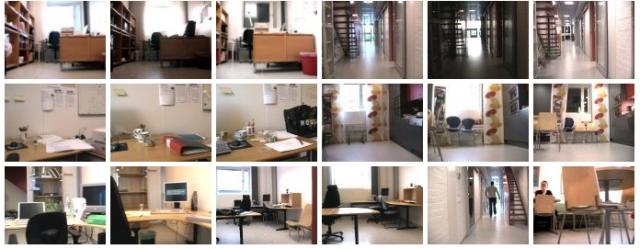- ImageCLEF 2024
- LifeCLEF 2024
- ImageCLEF 2023
- LifeCLEF 2023
- ImageCLEF 2022
- LifeCLEF2022
- ImageCLEF 2021
- LifeCLEF 2021
- ImageCLEF 2020
- LifeCLEF 2020
- ImageCLEF 2019
- LifeCLEF 2019
- ImageCLEF 2018
- LifeCLEF 2018
- ImageCLEF 2017
- LifeCLEF2017
- ImageCLEF 2016
- LifeCLEF 2016
- ImageCLEF 2015
- LifeCLEF 2015
- ImageCLEF 2014
- LifeCLEF 2014
- ImageCLEF 2013
- ImageCLEF 2012
- ImageCLEF 2011
- ImageCLEF 2010
- ImageCLEF 2009
- ImageCLEF 2008
- ImageCLEF 2007
- ImageCLEF 2006
- ImageCLEF 2005
- ImageCLEF 2004
- ImageCLEF 2003
- Publications
- Old resources
You are here
ImageCLEF 2009 Robot Vision Task
ImageCLEF hosted for the first time a Robot Vision task in 2009. The task addressed the problem of topological localization of a mobile robot using visual information. Specifically, participants were asked to determine the topological location of a robot based on images acquired with a perspective camera mounted on a robot platform. See below for a more detailed description of the task.
RobotVision@ImageCLEF'09 is now over and the final results were released. You can learn more about several interesting approaches used by the participants here.
Description of the Task
Participants are given training data consisting of an image sequence recorded in a five room subsection of an indoor environment under fixed illumination conditions and at a given time. The challenge is to build a system able to answer the question 'where are you?' (I'm in the kitchen, in the corridor, etc.) when presented with a test sequence containing images acquired in the previously observed part of the environment or in additional rooms that were not imaged in the training sequence. The test images were acquired 6-20 months later after the training sequence, possibly under different illumination settings. The system should assign each test image to one of the rooms that were present in the training sequence or indicate that the image comes from a room that was not included during training. Moreover, the system can refrain from making a decision (e.g. in the case of lack of confidence).
The algorithm must be able to provide information about the location of the robot separately for each test image (obligatory task) (e.g. when only some of the images from the test sequences are available or the sequences are scrambled). This corresponds to the problem of global topological localization. However, results can also be reported for the case when the algorithm is allowed to exploit continuity of the sequences and rely on the test images acquired before the classified image (optional task). The reported results will be compared separately and winners will be announced for both types of problems.

Examples of images from the IDOL2 database showing the interiors of the rooms, variations observed over time and caused by activity in the environment as well as introduced by changing illumination.
Acquisition of a single sequence from the IDOL2 database.
The competition starts with the release of annotated training and validation data. Training and validation will be performed on a subset of the publically available IDOL2 Database. The database contains image sequences acquired in a five room subsection of an office environment, under three different illumination settings and over a time frame of 6 months. The test image sequences will be released two months later (see the schedule below). The test sequences were acquired in the same environment, 20 months after the training data, and contain additional rooms that were not imaged previously.
Detailed information about the task is available for registered participants at http://cogvis.nada.kth.se/robotclef09/
Contact Andrzej Pronobis in order to obtain an account required to access the page.
Schedule
15.1.2009: registration opens for all CLEF task
31.3.2009: training and validation data and task release
31.5.2009: test data release
15.6.2009: submission of runs
15.7.2009: release of results
15.8.2009: submission of working notes papers
30.9-2.10.2009: CLEF workshop in Corfu, Greece.
Organizers
Barbara Caputo, Idiap Research Institute, Martigny, Switzerland, bcaputo@idiap.ch
Andrzej Pronobis, Centre for Autonomous Systems, KTH, Stockholm, Sweden, pronobis@csc.kth.se
Patric Jensfelt, Centre for Autonomous Systems, KTH, Stockholm, Sweden, patric@csc.kth.se
